Australia
Birds of Australia

Princeton Guides – Birds of Australia 8th Editon by Simpson & Day 2010
An excellent reference book. It is a bit large to use in the field. However, this may be necessary to accommodate Australia’s 980 or so species.
The book follows the standard layout with birds on the right and text and maps on the left.
The images and maps are of excellent quality. However, it is a bit crowded, with an average of six species per page. The description is very brief. The taxonomic order is not specified. There is no mention of similar species that might be mistaken for the one you are looking at in the book.
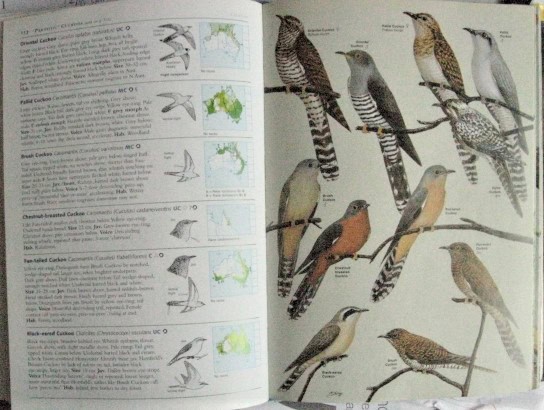
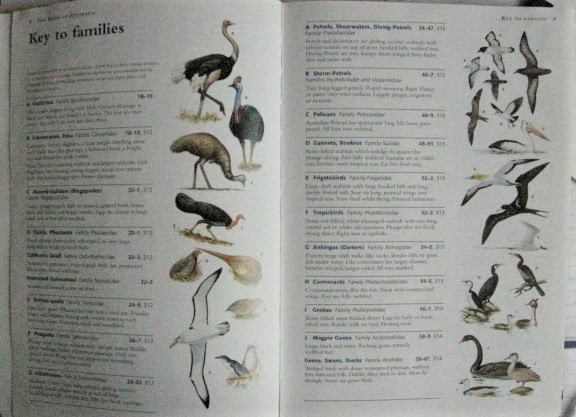
There are two indexes, one for scientific names and one in English. Unfortunately, the index lacks a bold, capital letter to separate letters of the alphabet.
Additional Information
The book has a family index at the front with a picture of a sample bird from each family. This is an excellent feature not in many other publications. (photo above).
An appendix at the back includes a chart showing each species’ breeding season, another handy feature not found in other publications.
There is a checklist for birds of Australia’s island colonies, such as Norfolk Island, Howe Island, and others. It is very useful if you intend to travel to these very remote islands.
Conclusion
The book has a paper cover that soon gets ripped and damaged with use. Under the paper cover is a lightweight plastic cover that tends to warp because it is wider than the book. The inside pages are of excellent quality, but the book could use a more robust cover.
Although several areas could be improved, this is an excellent publication overall.
Birdtripper members get 30% off Princeton books. Click members to register.
(M) Write a review
You must be logged in to submit a review. Go to Members page to Log-in or Register
Birds of Australia
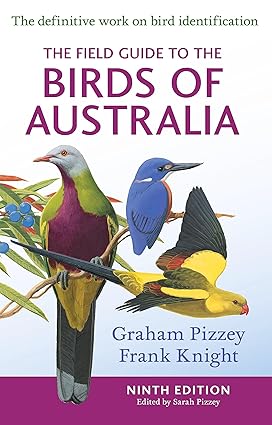
Harpercollins AU Field Guide to Birds of Australia by Graham PIzzey and Frank Knight 9th edition 2013
Like the Princeton book described above, this is an excellent book. Also, like the Princeton book, it is too large to be a field guide with 624 pages. This is unavoidable in accommodating the hundreds of species in Australia and 750 maps.
The book is updated to cover the latest taxonomy and includes 18 new species,a section on vagrants and a quick-find index.
Text by Pizzey and art by Knight. This edition was published in 2013, however Graham Pizzey died in 2001, which makes one wonder who is the real author of the book or perhaps it is just a reprint without changes.
(M) Write a review
You must be logged in to submit a review. Go to Members page to Log-in or Register
Finding the Birds of Australia
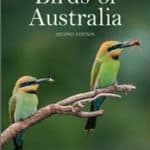
CSIRO Publishing -The Complete Guide to Finding the Birds of Australia by Andrew & McBride Second Edition 2011
This is not a bird guidebook. Instead, it tells you where to find the species you seek in Australia—an excellent book.
(M) Write a review
You must be logged in to submit a review. Go to Members page to Log-in or Register
New Zealand
Birds of New Zealand
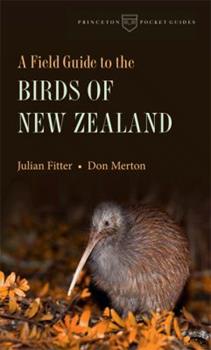
Princeton Field Guide to the Birds of New Zealand by Julian Fitter & Don Merton 2011
This book follows the standard layout for a field guide with birds on the right and text on the left. The images are high-quality photographs, but there are only one or two of each species. As a result, the book is smaller than most birding field guides.
Range maps are shown only for birds that breed in New Zealand or are regular visitors. There are no maps for migrants, of which there is a fair number.
The taxonomic order is that of the New Zealand Ornithological Society. There is no mention of birds of similar species that might affect your identification.
The index has English and Scientific names mixed, and there is only a tiny space between letters of the alphabet. This could be improved by writing in a capital letter for each alphabet section. I do this for many books that do not have this feature. The letters are tiny and light grey in colour, making them difficult to read for anyone who does not have 20-20 vision. A better index would improve this book a lot. I have seen many excellent publications that, for some reason, do not put any effort into creating a good index.
The cover is cardboard. The inside pages are of high quality.
Additional Information
At the back of the book is a seven-page listing of birding hotspots in New Zealand.
There is also a short list of birding tour operators
(M) Write a review
You must be logged in to submit a review. Go to Members page to Log-in or Register
Birds of New Zealand
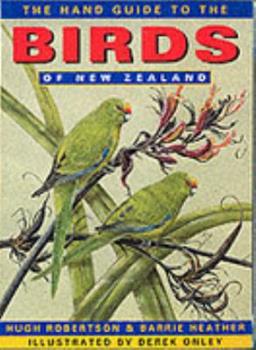
Penguin Hand Guide to the Birds of New Zealand, Revised Editon, by Robertson, Heather and Onley 2005
This book is called a “Hand Guide” instead of a “Field Guide”, which is unusual but of no importance, except perhaps when searching for a copy online.
It follows the standard layout with birds on the right and text and maps on the left. The images are drawings, not photographs. However, they are of high quality. The book shows from three to five species per page.
There are more maps than in the previous book, and they also show off-shore distribution as well as on land.
The taxonomic order is that of the Ornithology Society of New Zealand, and they officially endorse the publication. There is no mention of birds of similar species that might affect your identification.
The index is the same as the previous book, with English and Scientific names together and a slight separation between letters of the alphabet. But it at least has darker letters, and the page numbers are bold, which makes it a little easier to read than the light grey of the Princeton book.
The cover is cardboard, but it comes with an additional, removable, clear plastic cover for excellent protection from wear and the elements. In addition, the inside pages are of high quality.
Additional Information
There is a five-page section at the front of the book with information on good places to find birds.
(M) Write a review
You must be logged in to submit a review. Go to Members page to Log-in or Register
Comparison
The Princeton book features photographs, while the Penguin book has drawings. Both are good, and it is a matter of choice. The Penguin book has more pictures per species showing juvenile birds and both males and females if they are different.
Although the penguin book is much older, it is still an excellent publication. I went to New Zealand with both of these books. Together they give perfect coverage of the species of New Zealand.
Tip
When travelling to Australia and New Zealand, purchase your guidebook before you go. Don’t wait to buy it in the country.
- The book might not be available when you arrive for various reasons. For example, they could be sold out.
- Getting the books in advance gives you time to study the birds before you go.
- Australia and New Zealand are two of the most expensive countries globally. The Princeton book was published in the USA, Canada and the Philippines. I purchased it in Canada and later found that it cost almost double in Australia,